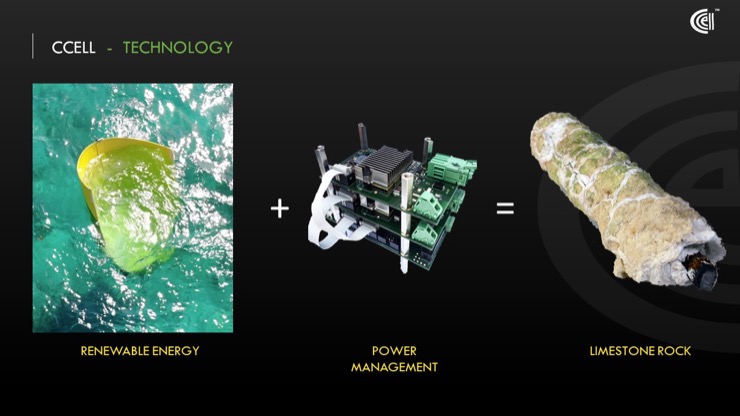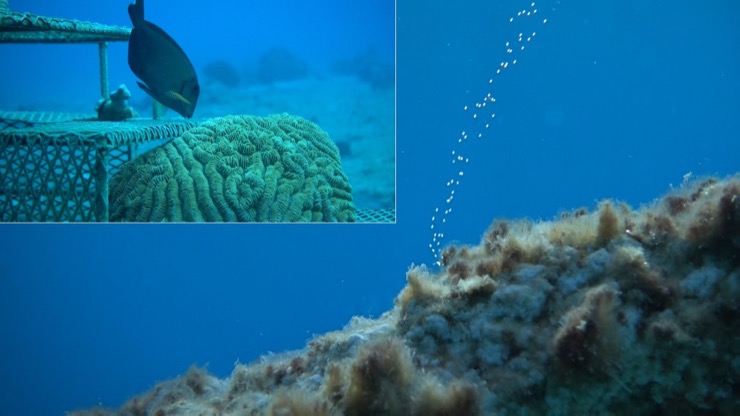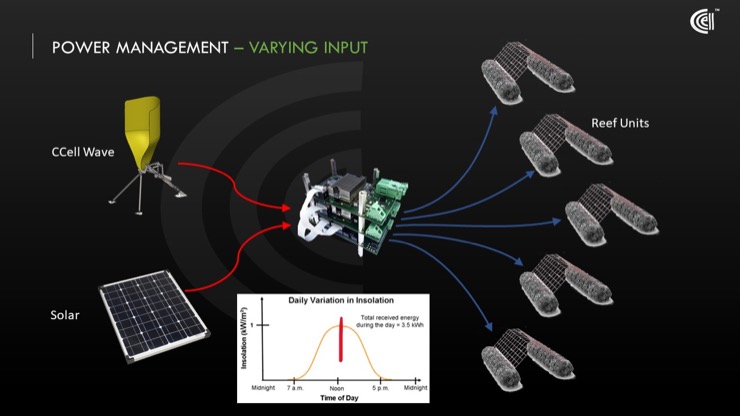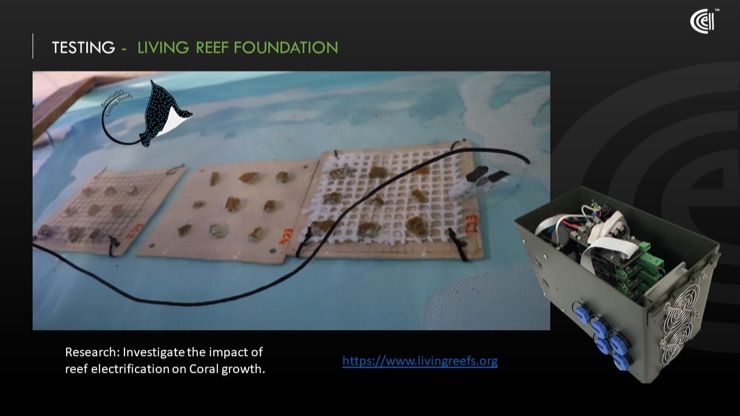


Our founder and CEO, Will Bateman, recently gave a webinar for The Institution of Environmental Sciences in which he described the problems our coastlines face and the ways in which we, at CCEll try to solve them. What follows is a transcript of the second section of this talk. You can find the first section here, it covers the problems coastlines face. This section will explain how we use electricity to grow coral reefs and the processing of renewable wave power that we do.

"To grow coral reefs using wave-power, there is a range of technologies that we are using. I am just going to step you through them and some of what we have learned in our journey to its current state, because I would like to be slightly different I am going to do this a little bit backwards, I am going to talk initially around the limestone and then we are going to talk about the power management behind that. Finally, we are going to talk about the wave paddle we have been developing (this will be covered in the next blog post).

So the process that we are using to essentially grow rock is not new. It has actually been around as a technique for about 30 years, and you may have actually come across when you were first doing chemistry at school. Seen above is a tank that we have at our office which is used as a demonstration of sorts, but essentially it is very similar to what you may have had at your chemistry class. On the right-hand side, we have an anode(+), and on the left, we have a cathode (-).

If you remember from your chemistry class you would have connected some power to this, and you would have seen oxygen bubbles rising off the anode, and you'd see hydrogen bubbles rising off the cathode. What you wouldn't have seen is the hydroxide cations that would also be created around the cathode, while around the anode you are releasing these hydrogen ions and, what is really interesting about those hydrogen ions is they actually react with calcium carbonate which is naturally found within the seawater. I am going to concentrate on calcium carbonate for now, but there are a lot of other minerals as well. But the hydrogen ions at the anode break that calcium carbonate into a highly charged calcium ion and we have some hydrogen bicarbonate. Then at the cathode we will have one of these hydroxide ions which actually does the exact opposite. The charged calcium ion is essentially attracted across towards the cathode, where it bumps into the hydroxide ion and into bicarbonate, which is readily available within the water and then transforms back into calcium carbonate. In other words, we have actually taken our calcium carbonate which was in solution in the seawater before we even started it, we have broken it down, we have pulled it across and put it onto our cathode. In other words, we are creating a pump for the deposition of calcium carbonate.

This is a real-life reef, the little bubbles coming out of here are hydrogen coming out of the cathode. This is a technical structure and you've got some corals being planted on there and crucially the fish don't seem too bothered by what is going on. It is, in fact, safe for them.
So, now we know how the reef grows, the next part of the puzzle is how do we actually provide power to the electrolysis. Because electrolysis is not easy, you have to be quite careful with the power you provide. I am just to going to step through all of the features we needed and/or wanted in order to actually make the electrolysis work really well and also so we could monitor and control what was going on.
Before we get to that, I am just going step back a little bit. First of all, we need some power from somewhere, and being that we want to move away from fossil fuels. We obviously don't want to be connecting to the grid, particularly on a lot of small islands; we want to be using renewable power where possible. Given that the waves are actually causing a lot of this damage, or a lot of the erosion, our belief has always been we ought to try to capture some of that power. To use wave energy, but at the same time, there are certain sites where the wave doesn't lend itself to energy capture, so we would use solar panels.

Our electronic box in the middle of this image has actually got to be able to handle both of these types of systems: solar and wave. We are quite agnostic in terms of power, that is we can handle power from different sources. But crucially, we also have to be able to cope with the variations in energy that comes from each of these devices. With the wave paddle, for example, the wave conditions are always changing but our device is actually moving backwards and forwards with time. So we are getting pulses of power coming from the wave paddle feeding back into the electronics, and with the solar panels, as you can appreciate at nighttime, you have no power at all. And in the beginning part of the day, energy starts to pick up, reaches its peak at midday and then drops back off again.
So, at the beginning part of the day, what we would often do is, we would only power 1 or 2 units of our reef structure. We break the reef up into a number of sections allowing us to power them independently. Now, we wouldn't want to starve these guys for a long period of time, so we will power a section up for a minute, or we could decide to power it up for only 10 seconds, then we will switch that up to another part of the reef, power that for a period of time and so on and so forth. When you get to midday, then you will say "Okay, I now have got full power available to me", if it's coming from the solar panels, "so I am therefore able to supply all of these different reef sections and provide power to all of them simultaneously." This is why a complex power management system is needed to maintain the power output to all these sections.
Now, let's come back a little bit to the electrolysis we were talking about earlier. The power output coming from our box is also really important, so if you remember back to your chemistry at school, you needed to provide at least 1.23 volts in order to get hydrogen and oxygen to bubble off. But to complete some of those other parts of the chemical reactions, shown above, in terms of breaking down the calcium and then reconstructing it, we actually need to provide a little bit more power than that. Let alone the fact that we do this process in the sea, which is filled with all kinds of minerals. We actually find the sea also starts to behave a little bit like a battery, so now we actually have to put in about 3.5-5 volts to drive this system.
To explain it further, at the cathode, there is the steel which we are growing our limestone rock around. But the rock is actually also slowly insulating the steel so, over time we are also going to want to increase the voltage that we are putting in because we want to overcome this resistance from the rock so we can continue to drive the reaction.

At CCell we have worked very hard to model everything we are doing from end to end; from the way we are distributing electricity around the reef to the design of the paddle and obviously the electronics. The red and blue flower shaped image is an illustration showing the possible position of the anode, you have our reef structure on the top, and we are looking at exactly where we should be positioning the anode to ensure we get the evenest distribution of rock across our structure. Now this is a very simple structure, but of course you may stack this up, you may also want to add different shapes, for example, some of the clients we are talking with would like to have a heart, or they might want to have a turtle-shaped reef. In order to be able to provide power to those structures, we have to think about where to best position our anodes and how we can actually control our power.
Another thing that is crucial, is where the table on the right comes in, this is that the sea doesn't just contain calcium carbonate and a little bit of salt; it actually contains a whole range of different chemicals and minerals. This is why it is important that we can control our voltage and the chemical reactions that are going to the right-hand side here. To ensure that we actually pick out what we want, unlike picking out things like magnesium which we don't want. For example, if you put too much power in you end up forming a very soft rock that you can almost carve your name in with a pen as it is main constituents (magnesium) makes its structure almost like cottage cheese.
Now, having put this reef out there, we are also going to want to be able to monitor what is going on We don't want to have to put divers into the water or go out to visit it all the time and we certainly don't want to have to move things around if there are changes to the reef structure. So what we also built into this box some health monitoring from two different directions. First off, we can measure the resistance of every single one of our reef structures independently. This means that, for example, if one of these structures was damaged, let's say after a hurricane or storm (or more likely someone runs into it with a boat), we can actually detect that change. If it's a significant change, we can obviously send someone out to inspect. Still, we can actually now redirect power to that particular reef unit to help repair it in an optimal way. The other side of this is, of course, we also want to monitor our wave paddle, which is also sitting out in the ocean. The paddle is being bashed around, and we want to be able to listen to the wear and tear on its bearings and seal to see that it's actually operating well.
Given that we want to do that monitoring, we have to send all of that data back to ourselves here in the UK. It then leads quite naturally on to saying: “Well, if you're doing that, why don't you collect other data?" – Why don't we put some cameras out on the reef so we can start to picture of what is going on in the reefs in realtime, just like you see webcam cameras around the world, why can't we add those on? We could also start to count fish; there is some interesting research being done right now on software that would automatically detect different kinds of fish. We can then feedback that information in terms of what's the marine ecology looking like, how diversified is it, are certain kinds of fish are under threat and are there any certain warning signs. Obviously we can start to measure temperature, it is actually something we do naturally anyway because we want to make sure, particularly for the electronics, that nothing is overheating. We can go on and on. So we can start to look at things like salinity, or we actually begin to measure other kinds of chemicals that are in the water that might be of particular interest for the marine biologist or other scientists, and including levels of pollution, if there has been an oil spill or some other event, maybe we can start to detect that. We very much want to want to see the units we are putting together here as a plug-and-play box into which we can aggregate data for a variety of sources; we feel that for the first time that we can do this on a scale that most people can't because we are in a perfect position. We are in the sea, going to be along large portions of the coastline meaning and we can start to measure on the scale that no one has ever done before. Now, it is often said that we know more about the surface of Mars than we do about our own oceans. I am not sure that is necessarily true, but it is certainly true that wave measurements are typically only measured with wave buoys that may be spaced every 30 kilometres. With our technology, we now have an opportunity to measure waves every 30 meters and get a much more accurate picture of what is going on.

We are not marine biologists, so when it comes to corals, we have very much handed over the responsibility. We sought support from a variety of organisations, so for example, we are working with the living reef foundation in Bermuda. They are running some trials using our kits. Above is the box we sent out to them which they are using to electrify small patches of reef structure, onto which they are putting small corals. The living reef foundation in Bermuda is unique; they are one of the few groups that are trying to grow corals from polyps, instead of just fragments of coral.
We are also doing some work with a team in the Bahamas. Unfortunately, they haven't been able to recover from the recent damage from the hurricane. But there they're growing corals from bigger pieces of coral they have sliced up, and they are also looking at how they can accelerate the growth of those, possibly using our technology.
The last team we are working with is in Mexico who are doing very similar work to the team in Grand Bahamas. Again they chop up different types of corals, but they are also looking at the resistance of those corals to different sorts of viruses and pollution. So, collectively, we hope that we can start to work more with these teams. We are working together to look very carefully at how electrolysis impacts the corals at different stages of their life. There is a certain amount of research to suggest that the corals will grow 2-3 even up to 5 times faster than they would in nature, due to the electrical current. In part because the electrolysis is actually metabolizing a lot of the minerals that are vital for coral growth, so they suddenly find those calcium ions that they needed, making it easier for them to grow much more rapidly. Just to give a counterexample to that, there are some concerns around what happens in the end; if you suddenly switch off the power do the corals continue to survive? There have been some studies where they have switched off the power and the corals actually died very quickly! So what we are doing about this is looking at how do we make it so we can turn off the power over a period of time, so the corals can transition to a state where there is no electricity, and its all looking very promising.

What I wanted to do within this presentation was also to throw in a couple of things that didn't go quite so well or didn't work or lessons we have learned over the last five years. As I have just been talking about Bermuda and how they were working on the system we sent out, above is the anode that we actually put into the tanks. On the left what it should look like, covered with epoxy, with the electrical cable coming in, it is all sealed in. The mesh is a special titanium mesh that isn't going to be eroded through use. What happened with this particular combination was that we forgot to put on this seal on before we packaged it up and send it out to them. So they put it in their test tank and switched it on and literally within 24 hours discovered that all of the electrical connections to the anode had essentially started to dissolve. In the middle are stainless steel bolts, you can see this washer has seriously been eaten into, and the copper plating in here has also started to erode away, so we don't actually get things perfect first time around but we've certainly learnt a lot as we go."